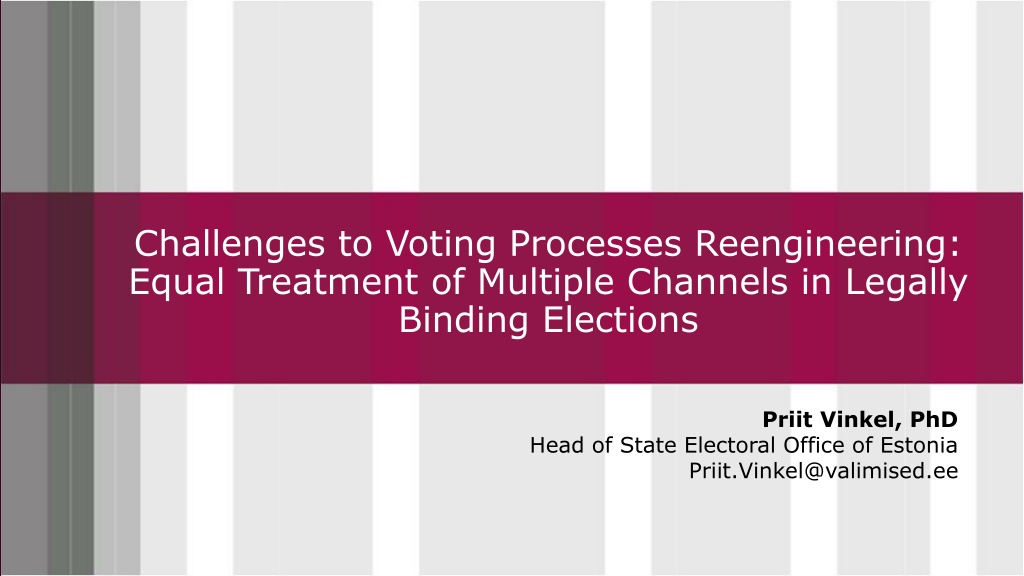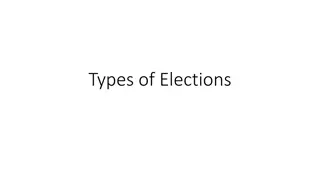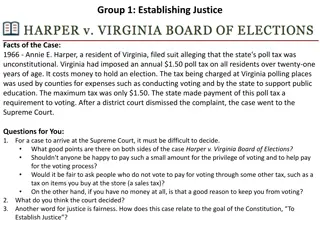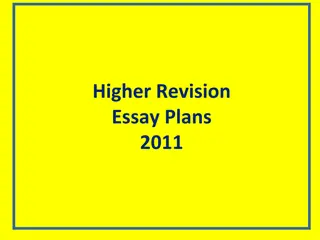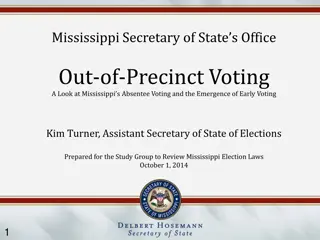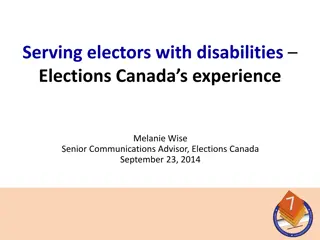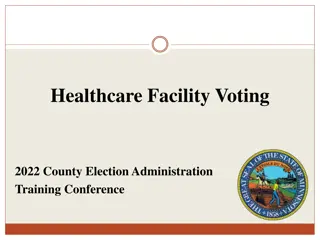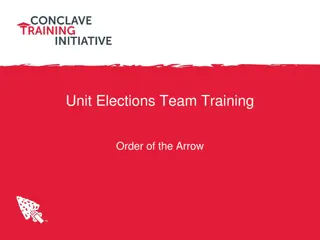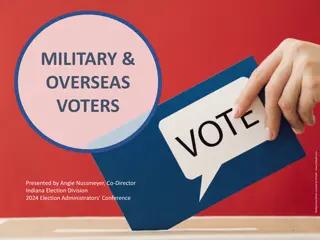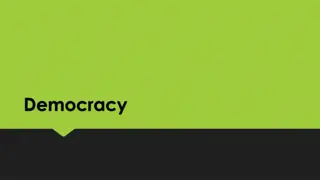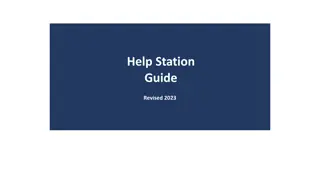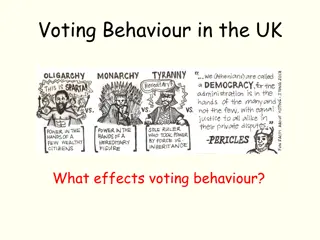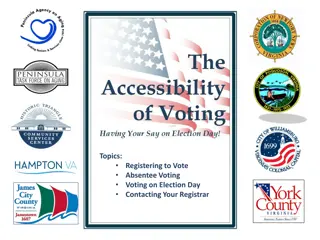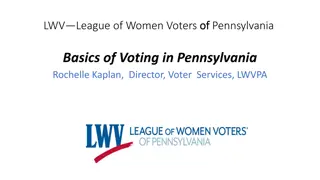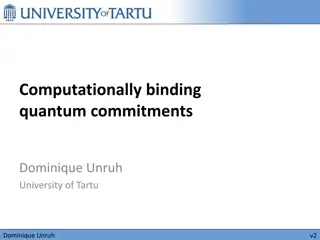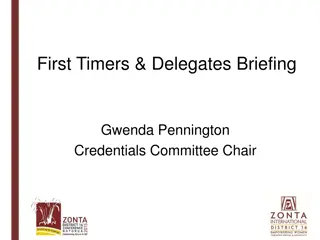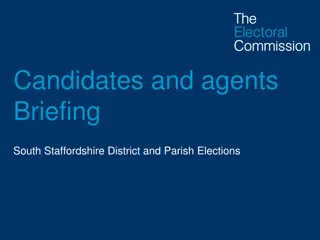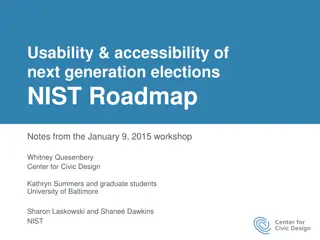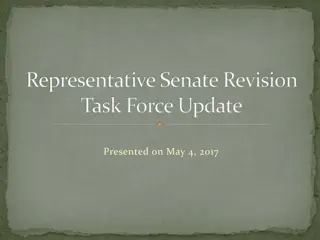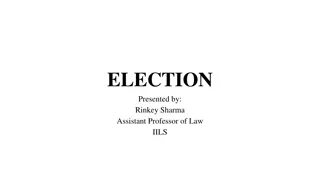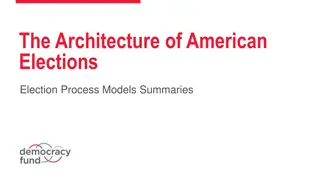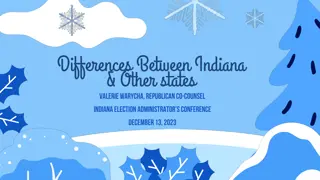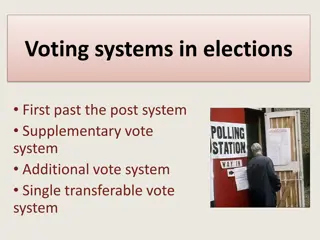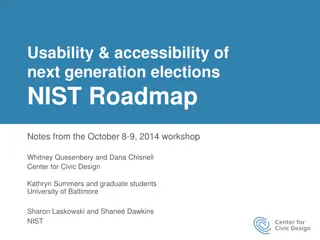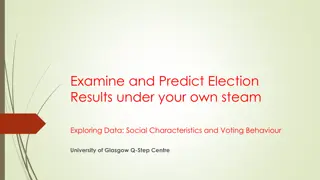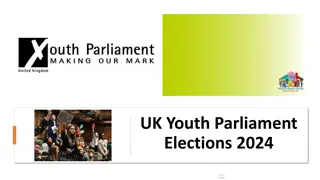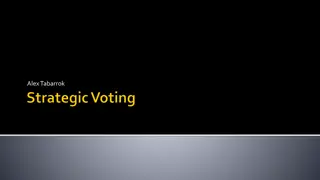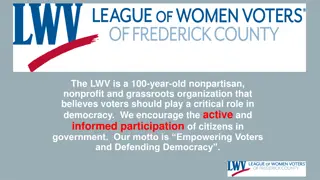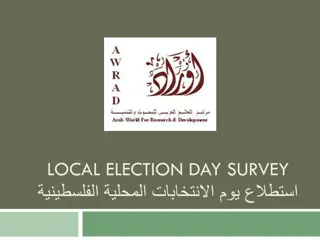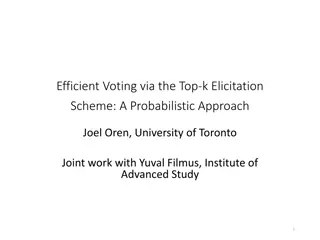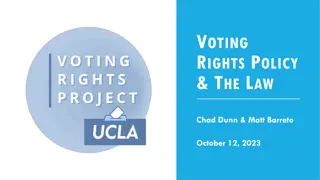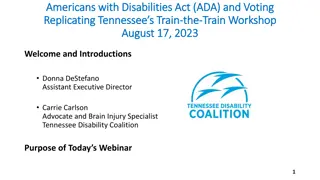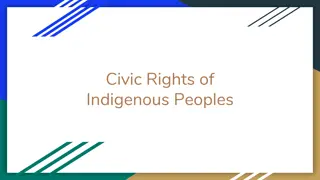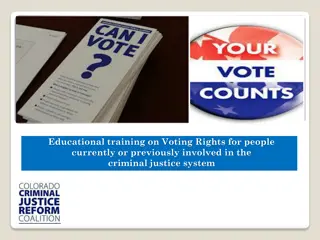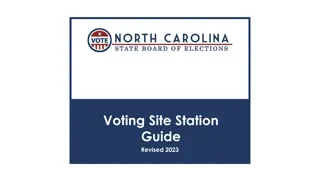Challenges in Reengineering Voting Processes: Equal Treatment of Multiple Channels in Legally Binding Elections
Addressing the decline in voter turnout by exploring the complexity of multi-channel elections, this research delves into the addition of alternative voting methods such as postal, advance, and internet voting. The study emphasizes the need for business process reengineering to adapt to evolving electoral processes.
- Voting processes
- Multi-channel elections
- Voter turnout
- Business process reengineering
- Electoral administration
Download Presentation

Please find below an Image/Link to download the presentation.
The content on the website is provided AS IS for your information and personal use only. It may not be sold, licensed, or shared on other websites without obtaining consent from the author. Download presentation by click this link. If you encounter any issues during the download, it is possible that the publisher has removed the file from their server.
E N D
Presentation Transcript
Challenges to Voting Processes Reengineering: Equal Treatment of Multiple Channels in Legally Binding Elections Priit Vinkel, PhD Head of State Electoral Office of Estonia Priit.Vinkel@valimised.ee 1
CoDE Cost of Democratic Elections Tallinn University of Technology Ragnar Nurkse Department of Innovation and Governance Prof. Dr. Robert Krimmer, Dr. David Duenas, Iuliia Krivonosova Dr. Priit Vinkel, Arne Koitm e 2
Outline Theoretical background; Research design and methodology; Case-study; Data; Discussion. 3
Theoretical background Decline of voter turnout in established democracies around the world (Lopez Pintor and Gratschew, 2002; Lijphart 1998): governments adding alternative means of voting, including Internet and postal voting (Kersting and Baldersheim 2004, Krimmer, Triessnig, and Volkamer 2007); complex multi-channel elections. 4
Multi-channel elections more than one voting channel is available to a voter. Alternative voting channels: Postal voting; Advance voting; Voting at diplomatic missions; Home voting; Proxy voting; Internet-voting. 5
Multi-channel elections increase the complexity for the election administration; the increase of complexity requires business process reengineering of electoral processes; and it involves analyzing the cost of introducing new voting channels (Xenakis 2004, Krimmer, Triessnig, and Volkamer 2007). 6
Addition of a new voting channel Times of short-term experiments and permanent reforms in the field of elections(James 2011, 37) Voters convenience; Turnout (Gronke, Galanes-Rosenbaum, and Miller 2007); 7
Addition of a new voting channel Times of short-term experiments and permanent reforms in the field of elections(James 2011, 37) Voters convenience; Turnout (Gronke, Galanes-Rosenbaum, and Miller 2007); Increase in complexity; Impact on quality of election administration; Increase in costs of elections (Montjoy 2010; Choi and Kim 2012; Gibson 2001). 8
Aim of CoDE project Empirical research into: a) how new voting channels are being undertaken; b) how they influence and change the voting process and governance; c) how the adding/removing of Internet voting and other channels impacts overall costs 9
Research objective What are the aims for introducing the concept of additional voting channels to existing election processes? How can business process reengineering be used and extended from single-channel elections to multi-channel elections and what cost categories have to be included for activity-based costing for elections? How do business processes look like for elections administering multiple voting channels, such as polling station-based (paper) voting, postal voting and Internet voting? Is it possible to design a unified business process for multi-channel elections? How can activity-based costing be applied to elections on the basis of a (unified) business process models? Would election administrators make different choices in regard to introducing voting channels if they knew about the most cost- effective combinations of channels (e.g. in terms of work and cost)? 10
Research design interdisciplinary theoretical framework incl. (1) election administration, (2) business process reengineering and (3) activity-based costing; an exploratory case study (Yin 2003) in order to conduct an in- depth study using multiple sources of evidence in its real-life context; a holistic multiple case study approach: cases will be contrasted and the goal is to match patterns using triangulation of the findings and examine whether they point to generalizable and converging conclusions (Kluge, 2000; Yin, 2003) to use them for input into a more general reference model. 11
Case selection Theoretical sampling approach (Yin, 2003): we took into account the style of government (confederation, federation, unitary), different kinds of supporting information systems (de/centralized) and additional voting channels (Internet voting, postal voting, both); Estonia is selected as the ideal first case (Unitary, Centralized, Internet voting) and as a critical case due to its electoral system tradition and conditions. 12
Estonia the first country in hosting an online binding election in 2005 (Springall et al, 2014); a front-runner country in matters of e-governance with its universal electronic key to all e-services (e-ID), digital signature, e-Health, e-taxboard, etc . (Madise and Vinkel, 2014); multiple international research projects on Estonian e-voting system: its adoption by citizens (Alvarez et al, 2009), its impact on the electoral turnout (Vassil and Weber, 2011) or the internal issues of e-voting processes (Maaten and Hall, 2008; Al-Ameen and Talab, 2013), amongst others. 13
Sources of information legal documents (including explanatory notes to draft acts); impact assessments (including internal instructions for the development of the electoral process, like Election Handbooks for Electoral Management Bodies); semi-structured interviews conducted with decision makers, administrative personnel and other stakeholders (election administrators, legislative committee in parliament, courts, NGOs, academics, journalists, etc.); election on-site observation and the recordings of the setting of the e-voting system; electoral budgets provided by local institutions; log files from the e-voting system; academic papers and media discussions on the issue. 14
Data analysis In the considered time frame of the electoral process, 31 processes including 177 activities are taking place in Estonia; Due to the high number of activities and for the purpose of comparison, we make a decision to focus only on the processes which are run differently for voting channels as it will allow us to make comparisons between voting channels: 1. Organization of voting place; 2. Voter identification; 3. Processing of votes; 4. Counting of votes. 15
Data analysis 1. Model for every process (BPMNs); 2. Activity-Based Costing analysis; 3. For final calculation of the cost per ballot, determine: the attributed time for the different activities; the labor costs; the practical capacities and the indirect costs; 4. Then, allocate costs to the corresponding voting channels, calculate cost per ballot and detect the potential cost-raisers for the electoral system hides; 5. Develop possible solutions for process improvement in terms of cost-efficiency. 16
Conclusions First results based on the Estonian case-work to be published in fall this year The outcome will give a handy tool for EMBs/policy planners worldwide by providing incentives for resource optimization and process improvement The framework allows for generally comparable results and the methodology and model are applicable to different contexts. However, the numerical results are case and context-dependent and should not be generalized 17
Q&A 18
Thank You! Priit.Vinkel@valimised.ee Contact at the TUT Prof Robert Krimmer Robert.Krimmer@ttu.ee 19
Cost pools Labour Cost Printing Cost Stationery Cost Transportation Cost Rental Cost Equipment Cost Depreciation Cost 20
TD ABC model for multichannel elections 1. Process modeling/process mapping for the considered time frame (for instance, with the help of Business Process Model and Notation BPMN). 2. Compliment these findings with interviews and on-site observations. Based on it, create a list of activities. 3. Select from the list those activities which are supposed to be organized differently depending on a voting channel. 4. Identify resource pools and determine the costs assigned to every resource pool. 5. Attribute costs to activities in order to receive total cost per activity. 6. Calculate the practical capacity of resources. 7. Divide total cost per activity by practical capacity to receive cost per minute per activity. 8. Divide time spent on every activity by output to receive cost per output (in our case, per ballot) per activity. Multiply this number by the unit cost of a resource pool in order to receive cost per ballot per activity. Sum up cost per ballot per all considered activities in order to receive cost per ballot per voting channel. 9. Compare costs per ballot per different voting channels. 21
Election day vote Advance vote E-vote 1 2 3 Delivery of equipment Stamping ballots before voting Setting the voting place (installing voting booths, ballot boxes) Delivery of equipment Stamping ballots before voting Organising information sessions Organising trainings for observers Setting the voting place (installing voting booths, ballot boxes) Advance voter identification in counties/in ordinary VDCs Processing of advance votes from outside Counting of advance ballots on the election day in 577 VDCs Setting up e-voting system Conducting the penetration test of e- voting system (RIA) 4 Voter identification 5 Manual counting of votes Ballots' transportation for recounting Testing e-voting system (RVT+VVK) Organising mock e-elections (public beta-testing) Configuration of the servers' infrastructure Daily checking servers Network monitoring Managing application Auditing Filming Processing of e-votes Prepare the list of e-voters (automated) Print e-voters lists Forward the e-voters lists to 15 counties Forward the list to 577 VDCs Make a notation in the list of voters 6 7 Recounting Ballots' transportation for recounting Recounting 8 9 10 11 12 13 14 15 16 23 17 18
